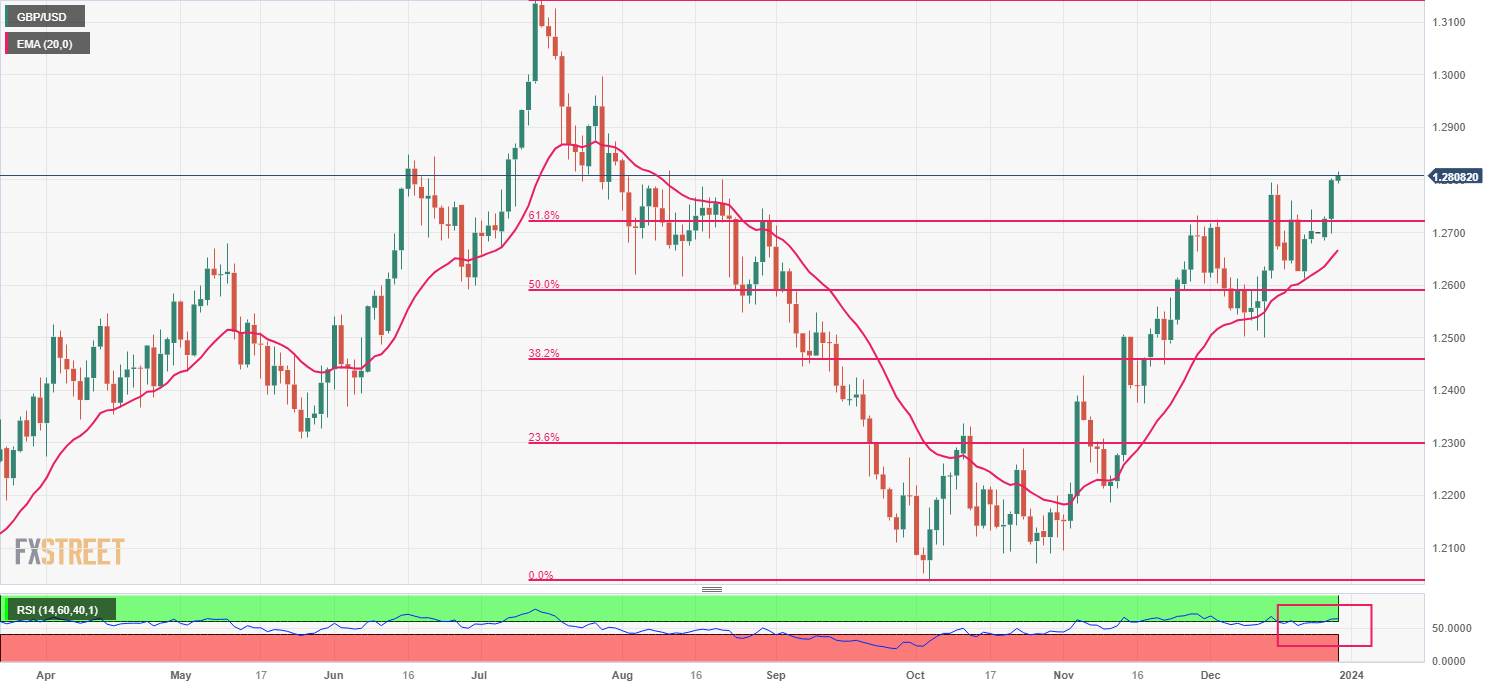- Pound Sterling eyes support near 1.2740 as the near-term demand is bullish due to upbeat market mood
- High inflation and recession fears in the UK may complicate the idea of BoE remaining a laggard in cutting rates.
- The economic calendar is light due to the festive season.
The Pound Sterling (GBP) fell vertically from fresh four-month high but is looking to recover as investors hope that the Bank of England (BoE) may maintain a restrictive monetary policy stance, knowing that inflation in the United Kingdom economy is highest in comaprison with other Group of Seven economies. The GBP/USD pair struggles to continue winning streak as the risk-appetite of the market participants has reduced despite early rate cut expectations from the Federal Reserve (Fed).
BoE policymakers are expected to face enormous difficulties as price pressures in the United Kingdom are high in comparison with other Group of Seven economies and the economy is on the verge of a technical recession due to deteriorating demand in domestic and overseas markets. The BoE could be forced to turn dovish due to economic shrinkage.
Daily Digest Market Movers: Pound Sterling eyes an intermediate cushion
- Pound Sterling fails to hold gains as investors worry about deepening fears of a recession in the UK economy.
- The demand for the Pound Sterling is fading as the Bank of England may not be the laggard in reducing borrowing costs.
- The expectations of a technical recession in the UK economy deepened after the Office for National Statistics (ONS) revised in a slight contraction in Q3 Gross Domestic Product (GDP) by 0.1%, escalating the need for early rate cut discussions.
- Chances for unwinding of BoE’s tight monetary policy stance would escalate if the UK economy shrinks in the last quarter of 2024.
- The BoE reported in its latest projections that the economy would remain stagnant in the last quarter.
- UK Finance Minister Jeremy Hunt said last week there is a reasonable chance that if we stick to the course, the administration would be able to bring inflation down and the central bank would start cutting interest rates.
- Meanwhile, the underlying inflation in the UK economy is still highest in comparison with other Group of Seven economies, which would keep BoE policymakers on toes.
- The UK core Consumer Price Index (CPI) has softened to 5.1% but is still more than double the required rate of 2% due to robust wage growth.
- BoE policymakers may divide on whether to keep restrictive monetary policy stance for a longer period or to start unwinding higher interest rates.
- On the US Dollar front, the US Dollar Index (DXY) finds cushion near 100.60, but broader demand is still weak.
- The overall market mood is still upbeat as investors lean towards expectations of early rate cuts by the Federal Reserve.
- The Fed is expected to start lowering borrowing costs from March as price pressures in the United States economy are clearly in a downtrend.
- This week, action in the FX domain has clearly indicated that markets are confident about early rate cuts by the Fed. The US Dollar may continue to face pressure despite thin trading volume and light economic docket.
- Meanwhile, the US Department of Labor has reported that individuals claiming jobless benefits for the first time were higher at 218K gaianst expectations of 210K and the former reading of 205K.
Technical Analysis: Pound Sterling drops below 1.2800
Pound Sterling failed to achieve a firm footing above 1.2800 as the risk appetite of the market participants as dropped. The Cable aims stability above the 61.8% Fibonacci retracement (plotted from July 14 high at 1.3142 to October 4 low at 1.2037) at 1.2740. The upward-sloping 20-day Exponential Moving Average (EMA) at 1.2670 continues to support the Pound Sterling bulls.
The Relative Strength Index (RSI) (14) has climbed above 60. Sustainability above aforementioned levels would trigger a bullish momentum.
Pound Sterling FAQs
What is the Pound Sterling?
The Pound Sterling (GBP) is the oldest currency in the world (886 AD) and the official currency of the United Kingdom. It is the fourth most traded unit for foreign exchange (FX) in the world, accounting for 12% of all transactions, averaging $630 billion a day, according to 2022 data.
Its key trading pairs are GBP/USD, aka ‘Cable’, which accounts for 11% of FX, GBP/JPY, or the ‘Dragon’ as it is known by traders (3%), and EUR/GBP (2%). The Pound Sterling is issued by the Bank of England (BoE).
How do the decisions of the Bank of England impact on the Pound Sterling?
The single most important factor influencing the value of the Pound Sterling is monetary policy decided by the Bank of England. The BoE bases its decisions on whether it has achieved its primary goal of “price stability” – a steady inflation rate of around 2%. Its primary tool for achieving this is the adjustment of interest rates.
When inflation is too high, the BoE will try to rein it in by raising interest rates, making it more expensive for people and businesses to access credit. This is generally positive for GBP, as higher interest rates make the UK a more attractive place for global investors to park their money.
When inflation falls too low it is a sign economic growth is slowing. In this scenario, the BoE will consider lowering interest rates to cheapen credit so businesses will borrow more to invest in growth-generating projects.
How does economic data influence the value of the Pound?
Data releases gauge the health of the economy and can impact the value of the Pound Sterling. Indicators such as GDP, Manufacturing and Services PMIs, and employment can all influence the direction of the GBP.
A strong economy is good for Sterling. Not only does it attract more foreign investment but it may encourage the BoE to put up interest rates, which will directly strengthen GBP. Otherwise, if economic data is weak, the Pound Sterling is likely to fall.
How does the Trade Balance impact the Pound?
Another significant data release for the Pound Sterling is the Trade Balance. This indicator measures the difference between what a country earns from its exports and what it spends on imports over a given period.
If a country produces highly sought-after exports, its currency will benefit purely from the extra demand created from foreign buyers seeking to purchase these goods. Therefore, a positive net Trade Balance strengthens a currency and vice versa for a negative balance.
Information on these pages contains forward-looking statements that involve risks and uncertainties. Markets and instruments profiled on this page are for informational purposes only and should not in any way come across as a recommendation to buy or sell in these assets. You should do your own thorough research before making any investment decisions. FXStreet does not in any way guarantee that this information is free from mistakes, errors, or material misstatements. It also does not guarantee that this information is of a timely nature. Investing in Open Markets involves a great deal of risk, including the loss of all or a portion of your investment, as well as emotional distress. All risks, losses and costs associated with investing, including total loss of principal, are your responsibility. The views and opinions expressed in this article are those of the authors and do not necessarily reflect the official policy or position of FXStreet nor its advertisers. The author will not be held responsible for information that is found at the end of links posted on this page.
If not otherwise explicitly mentioned in the body of the article, at the time of writing, the author has no position in any stock mentioned in this article and no business relationship with any company mentioned. The author has not received compensation for writing this article, other than from FXStreet.
FXStreet and the author do not provide personalized recommendations. The author makes no representations as to the accuracy, completeness, or suitability of this information. FXStreet and the author will not be liable for any errors, omissions or any losses, injuries or damages arising from this information and its display or use. Errors and omissions excepted.
The author and FXStreet are not registered investment advisors and nothing in this article is intended to be investment advice.
Recommended content
Editors’ Picks

AUD/USD: Rally continues to target 0.6400
AUD/USD’s upside momentum remained unchallenged on Tuesday, with the pair rising for the fifth consecutive daily advance and coming at shouting distance from the key resistance area in the 0.6400 neighbourhood.

EUR/USD: Correction has further legs to go
EUR/USD remained under pressure, adding to Monday’s retracement and breaking below the key 1.1300 support to reach two-day troughs, leaving the door open to the continuation of this correction in the short-term horizon.

Gold embarks on a consolidative move around $3,200
Gold is holding its own on Tuesday, trading just above $3,200 per troy ounce as it bounces back from earlier losses. While a more upbeat risk sentiment is bolstering the rebound, lingering concerns over a deepening global trade rift have prevented XAU/USD from rallying too aggressively.

Ethereum staking balance declines as whales resume buying
Ethereum is down 2% on Tuesday following a 120K ETH decline in the net balance of staking protocols in the past five days. While the decreasing staking balance could accelerate selling pressure, the resumption of whale buying activity could help the top altcoin defend a key ascending triangle's support.

Is a recession looming?
Wall Street skyrockets after Trump announces tariff delay. But gains remain limited as Trade War with China continues. Recession odds have eased, but investors remain fearful. The worst may not be over, deeper market wounds still possible.

The Best brokers to trade EUR/USD
SPONSORED Discover the top brokers for trading EUR/USD in 2025. Our list features brokers with competitive spreads, fast execution, and powerful platforms. Whether you're a beginner or an expert, find the right partner to navigate the dynamic Forex market.




